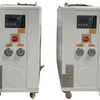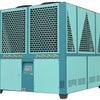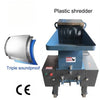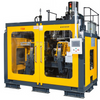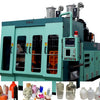Technological Advancements and Industrial Applications of 5L Blow Molding Machines Abstract

1. Introduction
Blow molding machines are critical to the plastic processing industry, enabling the production of hollow plastic products through the inflation of heated thermoplastic materials. The 5L blow molding machine, designed for medium-volume production (e.g., liquid containers, industrial drums), has gained prominence due to its versatility and efficiency. With China’s blow molding machine market projected to reach 40 billion domestically by 2025 (CAGR: 10%), advancements in 5L machines have been driven by demand for eco-friendly packaging, precision manufacturing, and cost-effective solutions. This paper explores the technical evolution, industrial applications, and future prospects of 5L blow molding machines.
2. Technical Principles and Design Features
2.1 Core Mechanism
5L blow molding machines operate through three primary stages:
- Extrusion: Plastic pellets (e.g., HDPE, PP, PET) are melted via a screw extruder (e.g., LS-S5L with a φ60 mm screw diameter and 24:1 L/D ratio). The screw rotates at 200 rpm, achieving an extrusion capacity of 65–80 kg/h.
- Molding: The molten parison is clamped into a mold cavity (max size: 370×390 mm for LS-S5L) and inflated using compressed air (pressure: 0.6–0.8 MPa).
- Cooling and Ejection: The molded product is cooled via water or air systems before ejection.
2.2 Key Design Innovations
- Multi-Layer Co-Extrusion: Models like the DHD-5LⅡ (Dinghao Machine) feature triple screws (φ60+φ50+φ30 mm) for multi-layer structures (e.g., EVOH barrier layers in food packaging).
- Intelligent Control: PLC systems (e.g., Siemens S7-1200) enable real-time adjustments to pressure, temperature, and cycle times.
- Energy Efficiency: Servo-driven motors reduce energy consumption by 30–40% compared to traditional hydraulic systems.
- High-Throughput Production: LS-S5L achieves 700 units/hour with a 6 L storage capacity and 60 kN clamping force.
3. Classification and Industrial Applications
3.1 Machine Types
| Type | Key Features | Typical Applications |
|---|---|---|
| Single-Layer Blow Molding | LS-S5L (φ60 mm screw, 700 units/hour) | Beverage bottles, detergent containers |
| Multi-Layer Blow Molding | DHD-5LⅡ (triple screws, 4模头) | Fuel tanks, chemical drums with barrier layers |
| Liquid Fertilizer Machines | Tongjia 5L Liquid Fertilizer Machine (φ70 mm screw) | Agricultural liquid packaging |
3.2 Sector-Specific Use Cases
-
Beverage Packaging:
- Production of 5L PET water bottles with high transparency and impact resistance.
- Integration with inline quality inspection systems (e.g., vision sensors for wall thickness).
-
Automotive Industry:
- Manufacturing multi-layer fuel tanks (DHD-5LⅡ) with EVOH barriers to reduce hydrocarbon emissions.
-
Agriculture:
- High-volume production of liquid fertilizer containers (Tongjia Machine) with corrosion-resistant HDPE.
-
Medical Sector:
- Sterile blow molding of IV solution bottles using FDA-compliant materials and stainless-steel components.
4. Challenges and Solutions
4.1 Material Diversity
- Problem: Variability in resin properties (e.g., viscosity of HDPE vs. PP) complicates uniform parison formation.
- Solution: Adaptive screw designs (e.g., LS-S5L’s variable pitch screw) and closed-loop temperature control.
4.2 Environmental Compliance
- Challenge: Meeting EU Directive 2019/904 (single-use plastics) and China’s "Dual Carbon" targets.
- Innovation: Development of biodegradable PLA-compatible machines and energy recovery systems (e.g., regenerative braking in servo motors).
4.3 Cost Optimization
- Issue: High energy consumption and maintenance costs for multi-layer machines.
- Advancement: Predictive maintenance via IoT sensors (e.g., vibration analysis for bearing health) and modular tooling designs.
5. Future Trends
5.1 Smart Manufacturing
- AI Integration: Machine learning algorithms for optimizing parison geometry and reducing material waste.
- Digital Twins: Virtual simulations to test mold designs before physical trials.
5.2 Circular Economy
- Recycling Compatibility: Designing machines to process post-consumer recycled (PCR) materials without compromising structural integrity.
- Biodegradable Materials: R&D in PHA- and PBS-based resins for compostable packaging.
5.3 Sustainability Metrics
- Carbon Footprint Reduction: Solar-powered blow molding lines and water-cooled systems cutting energy use to 1.5 kWh/kg output.
6. Conclusion
5L blow molding machines are pivotal in addressing global demand for sustainable, high-precision plastic products. Innovations in multi-layer technology, energy efficiency, and smart controls have expanded their applicability across industries. Future research should prioritize compatibility with bioplastics, AI-driven process optimization, and compliance with stringent environmental standards to align with circular economy goals.

